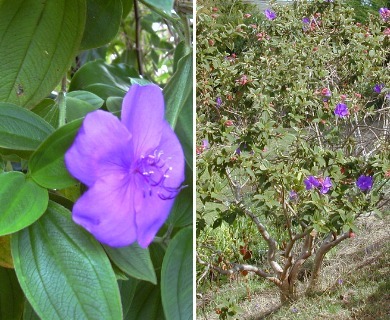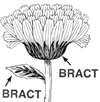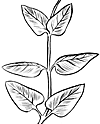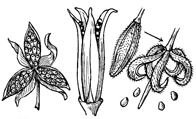Glorybush
Pleroma urvilleanum
Meadowbeauty family (Melastomataceae)
Post-Cook introduction
This introduced ornamental has escaped from gardens and become naturalized as a weed, forming impenetrable thickets. It has large showy flowers 3–4 inches (7.5–10 ) across the five spreading violet or purple petals. Distinguished also by the paired elliptical, velvety hairy leaves with five main veins from base.

©2004 Forest And Kim Starr
Leaves elliptical, with very hairy leafstalk 1⁄4– 3⁄4 inch (6–19 ) long. Blades elliptical, 2 1⁄4–5 inches (3–13 ) long and 1–2 1⁄2 inches (2.5–6 ) wide, long-pointed at blunt or rounded at base, edges straight, with five (sometimes seven) main veins from base; these and curved smaller veins sunken on upper surface and raised beneath. Upper surface yellow green, covered with pressed hairs; lower surface silvery or light green, velvety hairy. Dying leaves turning red above, silvery orange beneath.
Flower clusters () erect, large, branched, 3–5 inches (7.5–13 ) long. Flowers several but not opening together, very large and showy, on short hairy stalks, composed of 2 large hairy pointed pinkish or 1 inch (2.5 ) long and rose-red buds; densely hairy with narrow tube 5⁄8 inch (1.5 ) long, five narrow spreading hairy, reddish-tinged almost as long, shedding; five violet or purple petals about 1 1⁄2 inches (4 ) long and nearly as broad, oblong, broad and straight at widely spreading and falling early; 10 long threadlike purple of two sizes, bent in middle, with narrow curved and with hairy five-celled many tiny ovules, and long threadlike curved purple
is an egg-shaped pale brownish 5⁄16 inch (8 ) long, five-celled, with many small round seeds.
The wood is reddish brown, hard, strong, and difficult to cut. Not used.
This species has become naturalized and is classed as a weed in pastures and wastelands. It forms dense thickets by spreading vegetatively from roots, and cut branches also bear roots and grow.
Scattered, forming impenetrable tangles in moist open forests and roadsides at 1500–4000 ft (457–1219 ) altitude, especially in the Volcano area of the island of Hawaii.
Special areas
Wahiawa, Volcanoes
Range
Naturalized through the Hawaiian Islands from Kauai and Oahu to Hawaii. Native of Brazil (Rio de Janeiro and Rio Grande do Sul) and widely cultivated as an ornamental.
Other common names
Urville glorybush, Hawaiian glorybush, tibuchina, lasiandra
Botanical
Tibouchina urvilleana (DC.) Cogn., Lasiandra urvilleana DC., Formerly identified as Tibouchina semidecandra Cogn., a related species also of Brazil.
Degener (1930) stated that it was introduced in about 1910 from South America, traced to an estate near Kurtistown, Hawaii. The first herbarium specimen was collected by Rock in August 1917 at Kalanilehua, Kilauea, Hawaii. It was spread by amateur horticulturists who took cuttings to their gardens. By 1930 this weed was observed in a garden near Honolulu. At that time Degener predicted the spread and also the replacement of native vegetation, which has since occurred. As he observed in 1970, this species exemplifies the difficulty of eradicating ornamentals cultivated in the islands that become weeds.
Two additional shrubby naturalized species in this family have become weeds. Koster’s curse, Clidemia hirta (L.) D. Don, has small white flowers and small blackish or purplish edible berries. Melastoma candidum D. Don ( melabathricum auth., not L.) has large pink to purple flowers and small bristly berrylike They are of no forage value and may be found in wastelands, pastures, and lowland forests.








